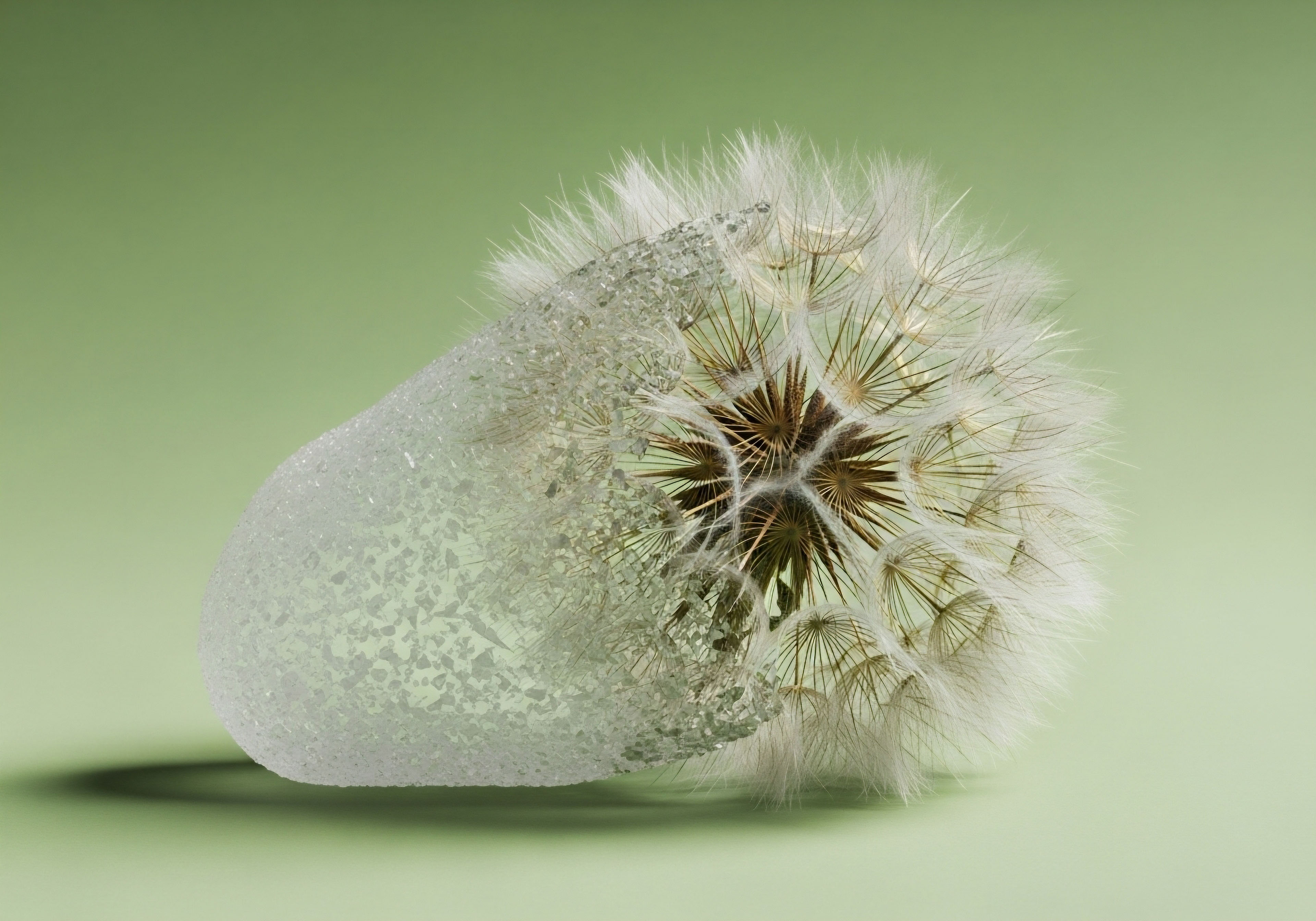

Fundamentals
You feel it in your energy, your recovery, your very sense of vitality. This internal barometer, so often dismissed as a subjective part of aging, has a profound physical anchor. It is tethered to the health of the vast, intricate network of blood vessels within you.
Consider your arteries and veins not as rigid pipes, but as dynamic, living tissues. Their ability to expand and contract in response to your body’s demands ∞ a quality known as vascular elasticity ∞ is a foundational pillar of physiological resilience. When this system is supple and responsive, blood flows freely, delivering oxygen and nutrients with silent efficiency. When it stiffens, the entire body feels the strain, a subtle yet pervasive tax on your functional capacity.
The architects of this vascular suppleness are, in large part, the hormonal messengers that govern your endocrine system. Hormones are the conductors of your internal orchestra, and their instructions directly influence the structural integrity and functional behavior of your blood vessels. This is where the concept of hormonal optimization becomes so deeply personal and biologically significant.
A protocol designed to restore hormonal balance is simultaneously a strategy to reclaim vascular health. The journey toward understanding this connection begins with acknowledging that the way you feel is a direct reflection of how your internal systems are functioning at a cellular level.

The Endocrine Influence on Vascular Tissues
Your blood vessels are lined with a delicate, single-cell-thick layer called the endothelium. This layer is a sophisticated biological sensor and regulator, constantly responding to chemical signals. Key hormones, including testosterone and estrogen, have a profound and direct relationship with this endothelial lining.
They interact with receptors on these cells, initiating cascades of biochemical events that dictate the vessel’s tone and health. For instance, these hormones are critical in modulating the production of nitric oxide, a potent vasodilator that signals the smooth muscles in the artery walls to relax, thereby increasing blood flow and reducing pressure.
As endocrine function shifts with age, the production of these key hormones declines. This reduction in signaling can lead to a decrease in nitric oxide availability and an increase in factors that promote stiffness, such as inflammation and oxidative stress. The result is a gradual loss of vascular elasticity, a condition known as arterial stiffness.
This stiffening forces the heart to work harder to pump blood through the circulatory system, contributing to a cascade of downstream health concerns. Hormonal optimization protocols are designed to address this decline by replenishing the body’s signaling molecules, thereby supporting the endothelium’s ability to maintain a healthy, elastic state.
Hormonal balance is a primary regulator of the cellular functions that preserve the supple, responsive nature of your blood vessels.

What Defines Vascular Elasticity?
Vascular elasticity refers to the intrinsic ability of your arteries to stretch and recoil with each heartbeat. Think of a new, high-quality elastic band; it stretches easily and snaps back to its original shape. An older, brittle band, however, is stiff and may crack under pressure. Your arteries function in a similar manner. This property is vital for two primary reasons:
- Buffering Blood Pressure. With each contraction, the heart ejects a powerful surge of blood into the aorta. Elastic arteries expand to accommodate this surge, absorbing the pressure wave. As they recoil, they push the blood forward, ensuring smooth, continuous flow throughout the body. This buffering action protects smaller, more delicate vessels from the damaging force of high-pressure pulses.
- Ensuring Efficient Blood Flow. The “snap-back” or recoil of elastic arteries provides an additional push to the blood, a phenomenon known as the Windkessel effect. This maintains diastolic blood pressure and ensures that tissues and organs receive a steady supply of oxygenated blood, even when the heart is relaxed between beats.
The structural components responsible for this property are proteins within the arterial wall, primarily elastin and collagen. Elastin provides the flexibility, while collagen provides strength and prevents overstretching. The health and balance of these proteins are directly influenced by the endocrine environment. Hormonal signals regulate their synthesis, repair, and degradation, ensuring the vascular system remains both strong and pliable. A decline in these signals can disrupt this delicate balance, favoring a stiffer, more collagen-dominant architecture.


Intermediate
To appreciate how hormonal optimization protocols directly influence vascular health, we must move beyond general concepts and examine the specific biochemical mechanisms at play. The conversation shifts from what hormones do to how they do it.
The protocols used in clinical practice ∞ such as Testosterone Replacement Therapy (TRT) for men and women, or the use of Growth Hormone Peptides ∞ are interventions designed to restore specific signaling pathways that have become attenuated over time. These pathways converge on the endothelial cells and vascular smooth muscle cells, the two primary tissues that dictate arterial elasticity and overall vascular function.
The core of this process lies in the modulation of vasodilators and vasoconstrictors, the maintenance of structural proteins, and the mitigation of inflammatory processes that contribute to vascular aging. Hormones like testosterone, estrogen, and progesterone, along with the growth hormone/IGF-1 axis, are powerful regulators of these functions. By understanding their distinct and synergistic roles, we can construct a clear picture of how a well-designed biochemical recalibration can translate into improved cardiovascular resilience.

Testosterone and Nitric Oxide Bioavailability
One of the most well-documented effects of testosterone is its positive influence on the bioavailability of nitric oxide (NO). Nitric oxide is the body’s most potent endogenous vasodilator. It is synthesized within the endothelial cells by an enzyme called endothelial nitric oxide synthase (eNOS).
Once produced, NO diffuses into the adjacent vascular smooth muscle cells, triggering a signaling cascade that causes them to relax. This relaxation widens the blood vessel, a process known as vasodilation, which lowers blood pressure and improves blood flow.
Testosterone supports this pathway in several ways:
- Upregulation of eNOS. Clinical evidence demonstrates that testosterone can increase the expression and activity of the eNOS enzyme. More enzyme availability means a greater capacity for NO production in response to physiological demands, such as exercise.
- Reduction of Inhibitors. The body produces an endogenous inhibitor of eNOS called asymmetric dimethylarginine (ADMA). Elevated ADMA levels are strongly associated with endothelial dysfunction and arterial stiffness. Studies have shown that testosterone replacement therapy in hypogonadal men can reduce circulating levels of ADMA, effectively removing a brake on NO production.
- Non-Genomic Effects. Beyond its influence on gene expression (genomic effects), testosterone can also exert rapid, non-genomic effects. It can modulate ion channels in the cell membranes of vascular smooth muscle, leading to rapid relaxation and vasodilation. This dual action provides both short-term and long-term support for vascular responsiveness.
For men on a standard TRT protocol involving weekly injections of Testosterone Cypionate, these mechanisms work to restore the NO pathway toward a more youthful state of function. The inclusion of ancillary medications like Anastrozole to manage estrogen conversion ensures that the hormonal balance is optimized for these vascular benefits without creating unintended side effects.
Optimized testosterone levels directly enhance the production of nitric oxide, the master regulator of vascular relaxation and blood flow.

How Do Estrogen and Progesterone Contribute to Vascular Health?
While often associated primarily with female physiology, estrogen and testosterone work in concert in both sexes to maintain vascular health. In women, particularly during the peri- and post-menopausal transitions, declining estrogen levels are a significant contributor to increased arterial stiffness. Low-dose testosterone therapy for women, often combined with progesterone, aims to restore the synergistic benefits of these hormones.
Estrogen contributes to vascular elasticity through several distinct mechanisms. It promotes the health of the endothelium, supports NO production similarly to testosterone, and also exerts powerful anti-inflammatory and antioxidant effects within the vessel wall. Furthermore, estrogen helps regulate the balance between elastin and collagen, favoring the maintenance of the flexible elastin fibers that are essential for arterial recoil.
Progesterone complements these effects. It has its own vasodilatory properties, helping to relax vascular smooth muscle and regulate vascular tone. Progesterone receptors are present on endothelial cells, suggesting a direct role in modulating vascular function. A properly structured protocol for women considers the status of all these hormones, using Testosterone Cypionate for its systemic benefits, and Progesterone to support uterine health and provide its own unique cardiovascular advantages.
| Hormone | Primary Mechanism of Action | Effect on Vascular Tone | Impact on Structural Proteins |
|---|---|---|---|
| Testosterone | Increases eNOS activity and reduces ADMA | Promotes Vasodilation | Supports endothelial repair |
| Estrogen | Enhances NO production and reduces inflammation | Promotes Vasodilation | Maintains elastin/collagen ratio |
| Progesterone | Directly relaxes vascular smooth muscle | Promotes Vasodilation | Modulates endothelial function |
| Growth Hormone / IGF-1 | Stimulates NO production and cellular repair | Promotes Vasodilation | Supports vascular repair and integrity |

The Role of Growth Hormone Peptides
Growth Hormone (GH) Peptide Therapy, utilizing compounds like Sermorelin or the combination of Ipamorelin and CJC-1295, represents another pillar of hormonal optimization with significant vascular implications. These peptides stimulate the pituitary gland to produce the body’s own natural GH in a pulsatile manner. GH then travels to the liver and other tissues, where it stimulates the production of Insulin-like Growth Factor-1 (IGF-1).
Both GH and IGF-1 have beneficial effects on the cardiovascular system. They enhance endothelial function, increase nitric oxide production, and have been shown to reduce arterial stiffness. This pathway is distinct from, yet complementary to, the actions of gonadal steroids.
By supporting the GH/IGF-1 axis, peptide therapy contributes to the overall goal of maintaining a healthy and responsive vascular system, which is why it is often integrated into comprehensive wellness protocols for active adults seeking to optimize recovery and long-term function.


Academic
An advanced examination of hormonal optimization’s influence on vascular elasticity requires a shift in perspective from systemic effects to the molecular and cellular dialogues occurring within the vessel wall. The interplay is a sophisticated dance of genomic and non-genomic signaling, endothelial cell lifecycle management, and the intricate regulation of the extracellular matrix.
The efficacy of protocols involving agents like Testosterone Cypionate, Gonadorelin, and Growth Hormone secretagogues is rooted in their ability to modulate these fundamental biological processes, pushing back against the molecular drivers of vascular aging.
Our dominant path of exploration will focus on the concept of endothelial senescence ∞ the irreversible state of growth arrest in the cells lining our arteries ∞ and how hormonal signaling directly counteracts this degenerative process.
This cellular aging is a primary contributor to the loss of vascular elasticity, as senescent endothelial cells exhibit a pro-inflammatory, pro-thrombotic phenotype and a severely diminished capacity to produce nitric oxide. Hormonal optimization, viewed through this lens, is a strategy to preserve the functional youth of the endothelium.

Genomic and Non-Genomic Androgen Signaling in Vasculature
The classical understanding of testosterone’s action is genomic. The hormone diffuses into a cell, binds to the intracellular androgen receptor (AR), and this complex then translocates to the nucleus, where it acts as a transcription factor to alter gene expression.
In endothelial cells, this genomic pathway is responsible for the sustained upregulation of the endothelial nitric oxide synthase (eNOS) gene, leading to a greater reservoir of the enzyme responsible for vasodilation. This is a process that unfolds over hours and days, providing a long-term architectural benefit to the vascular system.
However, a substantial body of evidence now points to rapid, non-genomic actions of testosterone that are critical for vascular reactivity. These effects occur within seconds to minutes and are mediated by ARs located on the cell membrane or through mechanisms independent of the classical AR. These pathways include:
- Modulation of Ion Channels. Testosterone can rapidly alter the flow of potassium (K+) and calcium (Ca2+) ions across the membranes of vascular smooth muscle cells (VSMCs). By opening K+ channels, it causes hyperpolarization of the cell membrane, which in turn closes voltage-gated Ca2+ channels. The resulting decrease in intracellular calcium concentration leads to rapid smooth muscle relaxation and vasodilation.
- Kinase Activation. Membrane-bound ARs can trigger intracellular signaling cascades, such as the PI3K/Akt pathway. Activation of this pathway can phosphorylate and activate eNOS in a manner independent of gene transcription, leading to a rapid burst of NO production.
This dual-modality signaling illustrates the sophistication of hormonal influence. A TRT protocol provides both immediate functional benefits through non-genomic pathways and long-term structural and functional improvements via genomic regulation. This comprehensive action is fundamental to restoring vascular elasticity.
Hormonal protocols leverage both rapid and sustained molecular signaling pathways to restore the function of the cells lining the blood vessels.

Can Hormonal Protocols Mitigate Endothelial Senescence?
Endothelial senescence is a hallmark of vascular aging. As endothelial cells divide over a lifetime, their telomeres shorten, eventually triggering a state of permanent cell cycle arrest. Senescent cells are dysfunctional; they secrete inflammatory cytokines, express adhesion molecules that attract immune cells, and, most critically, they uncouple eNOS. Uncoupled eNOS produces superoxide radicals instead of nitric oxide, transforming a vital enzyme into a source of oxidative stress. This actively promotes vascular stiffness and dysfunction.
Testosterone has been shown to counteract this process. Studies indicate that androgens can promote the activity of telomerase, the enzyme that rebuilds telomeres, thereby delaying the onset of replicative senescence in endothelial progenitor cells (EPCs). EPCs are critical for repairing damaged endothelium.
By maintaining a healthy pool of these progenitor cells and delaying senescence in mature endothelial cells, testosterone helps preserve the integrity and functionality of the vascular lining. This is a powerful anti-aging effect at the most fundamental level of vascular biology.
| Molecular Target | Effect of Testosterone | Effect of GH/IGF-1 | Net Impact on Vascular Elasticity |
|---|---|---|---|
| eNOS Enzyme | Upregulates gene expression (genomic); Activates via PI3K/Akt (non-genomic) | Increases expression and activity | Increased Nitric Oxide Bioavailability |
| Telomerase | Increases activity in endothelial progenitor cells | Supports cellular repair and health | Delayed Endothelial Senescence |
| Asymmetric Dimethylarginine (ADMA) | Lowers circulating levels | Improves overall metabolic health | Reduced eNOS Inhibition |
| Inflammatory Cytokines (e.g. IL-6) | Suppresses expression | Modulates inflammatory response | Reduced Vascular Inflammation |
| Extracellular Matrix Proteins | Modulates synthesis of collagen and elastin | Promotes tissue repair | Maintained Structural Integrity |

Systemic Integration with Peptide Therapies
The academic view must also be a systems-biology view. The vascular benefits of gonadal steroids do not occur in a vacuum. They are amplified and supported by other endocrine axes, particularly the GH/IGF-1 axis stimulated by peptides like Tesamorelin or Ipamorelin/CJC-1295. IGF-1 shares some signaling pathways with testosterone, including the activation of the PI3K/Akt pathway that leads to eNOS phosphorylation.
Furthermore, GH secretagogues have profound effects on body composition, specifically reducing visceral adipose tissue. This type of fat is metabolically active and a major source of the chronic, low-grade inflammation that drives endothelial senescence and dysfunction.
By reducing this inflammatory burden, peptide therapies create a more favorable systemic environment for the vascular-protective actions of optimized testosterone and estrogen to take effect. This multi-pronged approach ∞ directly supporting endothelial cell function while simultaneously reducing systemic inflammatory pressure ∞ is what makes a comprehensive hormonal optimization protocol so effective at preserving vascular elasticity.

References
- Hotta, Yutaro, et al. “Testosterone Deficiency and Endothelial Dysfunction ∞ Nitric Oxide, Asymmetric Dimethylarginine, and Endothelial Progenitor Cells.” Sexual Medicine Reviews, vol. 7, no. 4, 2019, pp. 661-668.
- G G, T. “Peptides for Cardiovascular Disease ∞ Healing the Heart from the Inside Out.” Apothecy, 2024.
- Rajkumar, C. et al. “Hormonal Therapy Increases Arterial Compliance in Postmenopausal Women.” Journal of the American College of Cardiology, vol. 30, no. 2, 1997, pp. 350-356.
- Moreau, K. L. et al. “Association between Arterial Stiffness and Variations in Estrogen-Related Genes.” Arteriosclerosis, Thrombosis, and Vascular Biology, vol. 28, no. 11, 2008, pp. 2129-2134.
- Thomas, Peter, and Meenu K. Singh. “Protective Actions of Progesterone in the Cardiovascular System ∞ Potential Role of Membrane Progesterone Receptors (mPRs) in Mediating Rapid Effects.” Steroids, vol. 78, no. 6, 2013, pp. 583-587.
- Worboys, S. et al. “Evidence That Parenteral Testosterone Therapy May Improve Endothelium-Dependent and -Independent Vasodilation in Postmenopausal Women Already Receiving Estrogen.” The Journal of Clinical Endocrinology & Metabolism, vol. 86, no. 1, 2001, pp. 158-161.
- Tivesten, Å. et al. “Testosterone and Atherosclerosis.” Steroids, vol. 78, no. 6, 2013, pp. 629-633.
- Tivesten, Åsa, and Claes Ohlsson. “The Role of Sex Hormones for Cardiovascular Disease in Men.” The Lancet Diabetes & Endocrinology, vol. 1, no. 1, 2013, pp. 79-91.

Reflection
The information presented here provides a map, a detailed biological chart connecting your internal chemistry to your physical vitality. It translates the abstract language of endocrinology into the tangible reality of how your body functions, moves, and feels. This knowledge serves a distinct purpose ∞ to shift your perspective from one of passive aging to one of proactive, informed self-stewardship.
The dialogue between your hormones and your vascular system is constant, a silent process that defines the upper limits of your physical potential each day.
Consider the resilience you seek in your life ∞ in your career, your relationships, your physical pursuits. That resilience has a physiological parallel in the elasticity of your arteries. Understanding this connection is the first, most definitive step. The next is to ask what your unique biology is communicating through the symptoms you experience and the data in your lab work.
This journey is yours alone, and it begins not with a protocol, but with a question ∞ What is my body telling me, and how can I begin to listen more closely?



